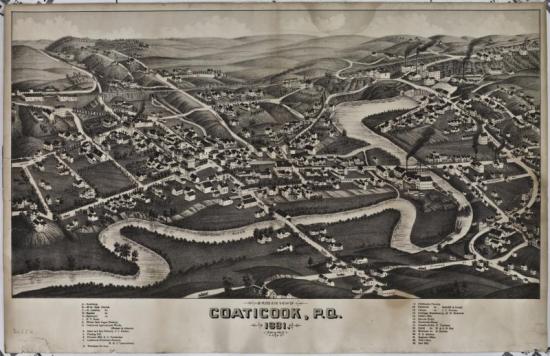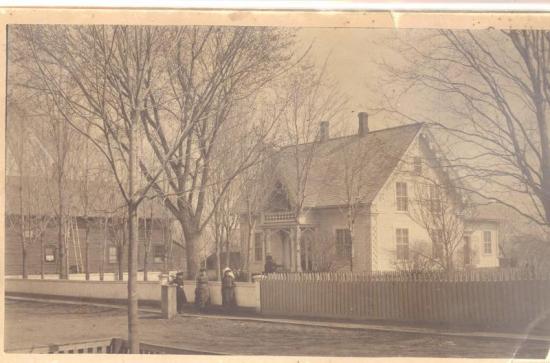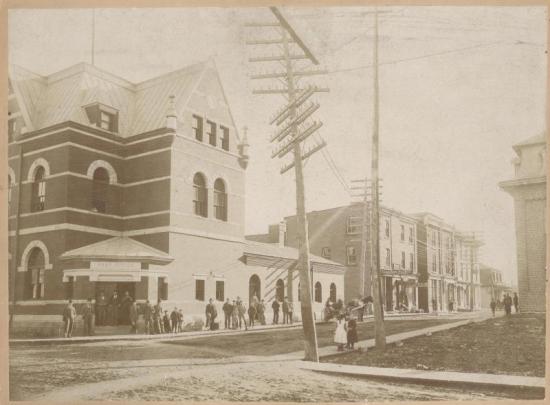Déjeuner-Causerie March 14th 2018
CUTTING
The Cutting name is an important name in and around the City of Coaticook. One of the streets in Coaticook is designated as Cutting Street which signifies the importance and the contribution by this family to the city of Coaticook. Jonathan Cutting played a key role as a speculator and settler in the early days of the future Coaticook. He was a hard worker who worked to acquire good agricultural property. He had two sons, Lucard and Horace, each of whom would leave their mark on the landscape of Coaticook. The Cuttings lived in a large house with a barn, outbuildings with a beautiful orchard nearby. Jonathan was a merchant and farmer and also held positions as a member of one of the five Barnston Township School Boards, a Justice of the Peace, member of the Board of Directors of the Stanstead County Agricultural Society. Jonathan would become owner of various properties some of which were located on the future site of the village of Coaticook. The position of ownership would bring him many advantages. All of the agricultural business was conducted with his son Lucard and provided them with significant monetary funds.
At this time, we note growing commercial activity. In association with his son Horace, commercial projects are being worked on He will support the commercial ventures with the help of his son Horace who was twenty -two years old in 1840. Marcus Child, a prominent merchant and politician would also assist.

Coaticook in 1881
Horace was born February 21, 1818 and he would marry Elizabeth (Laura) Baldwin in September 1844. Laura Baldwin was the daughter of Levi Baldwin. It was the custom in those days to marry someone from another influential family as it would bring certains advantages to the union. Therefore, Horace, who married this Miss Baldwin, entered into the large famly of Baldwins who were of importance to the village of Baldwin and to the beginning of Coaticook. He left the family home at the age of 23 years and moved to Stanstead where he worked as a sales clerk for Marcus Child. It did not take him long to go out on his own to start up commercial ventures. He built a store in 1842 in the center of what is now Coaticook, partnering up with Marcus Child in the process. In 1844, he ended his association with Marcus Child and decided to build the first hotel in Coaticook which was known locally as the Coaticook House. He was the first person to offer a tavern to the public. This establishment was very important to Horace for not only did it contribute to the development of the city but it also indicated that he was a good business man in that he was able to show a profit and to realize a good profit, at that. He also built a new store during this time and went into partnership with a man named Amos Fox.
In 1859, he had many functions: post master, merchant, held a seat as one of five counsilors on the town council.

Cutting's House
In 1860, he built a house for his family. This house was built in the American Gothic style (this house is currently owned by Henri Gerin and is located at 40, Gerin Lajoie Street). Horace would have liked to make Coaticook into a town resembling the same style as other villages in New England. Tradition has it that he wanted Coaticook to look like towns in England or New England. The make up of these towns usually consisted of an area where one would find stores, the church, the doctor, etc. This type of planning allowed the people to circulate, to meet and exchange views. Thus, the Upper Village of Coaticook in the district between Cutting and Union Streets was built in this manner. Old pictures of Coaticook are evidence of this neighborhood concept. Developing projects were also taking place a little further north. We find the industrial buildings in this sector. This would have been known as Coaticook's Lower Village where you would find these industries as they needed to take advantage of the nearby river.
In June 1862, John Foster became the first minister in the Anglican Church for the Townships of Barnston, Barford and Hereford.St. Stephen's Anglican Church was built and then opened in July 1863. The Rev. Foster went on to marry the eldes daughter of Cutting, Laura Elizabeth Cutting.
In 1867, Confederation year, Horace sold the Coaticook House to Stephen Davis. When Horace died in 1879, he had three daughters. Two of his eldest daughters decided to sell and to leave Coaticook and move to Massachusetts where they would live with their husbands.
In January 1850, Jonathan lost his wife Airis Keyes and two years later succumbs to the charms of Maria Murphy. She was an Irish woman and this would cause quite a stir in the family upon his remarriage in 1852. This marriage would produce three girls, born one after the other.
Lucard, as we have previously noted, was born in 1817 and would become the owner of the farm. He would have two sons, Edward and John. At the time of his death in 1884, he still was the owner of substantial pieces of property. Lucard, in effect, became the owner of the agricultural property that had been owned by Jonathan Cutting. With all this land and the business activity associated with the use of the land, Lucard would become an important person. Of the two sons, John decided that he would go and settle with his family in Massachusetts. Edward becane in charge of the farm. He was born in 1868 and died in 1946. He married Sarah Locke. A son, Leo, was born as well as other children. Follow the path of Leo, who, after the death of Edward, inherited 100 acres of land and the house.

Lower and Upper Village
Leo, grandfather to Gerald, was born in 1896 and died in 1970. He wed Loyola Carson who was of the Roman Catholic faith. Here is a second person in the Cutting family who would marry someone of a different religion. This couple would have two children: Everet and Unice.
Leo continued to work the land with the help of John. One day, however, John came to the point where he was unable to continue the cultivation of the land. An illness he had contracted prevented him from his work. Part of the land was sold to Antonio Lafaille and Leo kept for himself and his children another part of the large farm.
During the Second World War, Everet and Unice, children of Leo, enlisted in the armed forces to defend their country. They were part of the Allied effort which included Canada, England and France. This decision they took of their own free will because at the time, there was a law which allowed the children of a man with land to be exempt from enlisting. The children would not go to war because their work on the farm was considered necessary. They did not make use of this law as they preferred to take up their responsibilities to go and defend their country. Everett and Unice were on a ship bound for England in 1940. Everett was injured during the conflict and was returned to Canada and sent to the military hospital at Ste. Anne de Bellevue.
Let us take a little time now to tell about the beginning of Everett's love story at the military hospital in Ste. Anne de Bellevue. Everett received care from, among others, a woman named Rolande Desislet, who worked at this hospital. Once he regained his strength, he was discharged and returned to Coaticook. One evening, by chance, he decided to go and pass the time at the Child Hotel just for something to do. He met Rolande Desislet as well as her sister Dolores who had also come to the Child Hotel, to have some fun for themselves. You can imagine what took place after this meeting. This beautiful encounter, filled with promise, the two would go on to become a couple and this couple gave birth to a son named Gerald. Several years later and after some brilliant studies, Gerald was able to work in different places. His mother, however, informs him that a college, CEGEP, is opening its doors in Lennoxville. Gerald made out an application for a job at the college and was accepted.

Cutting street
The Cutting family had developed a strong sense of belonging to this area. When Leo, Gerald's grandfather passed away, he left a hundred acres of land to Gerald. Gerald has two sons who have told him not to sell the property because one day, they are planning to return to live here. This is how the love for this area is perpetuated. Mr. Cutting does not hesitate to remember that this area is rich in the good understanding between the English Canadians and the French Canadians which served to develop the region and allowed everyone to get along in a pleasant way. In fact, most of the inhabitants in the Coaticook area are of British or French descent and it is mutual aid and harmony that prevails in this area.
This article is based on information collected during Gerald Cutting's talk at the Breakfast Conference and taken from information in the book De Barnston a Coaticook written by historian Jean-Pierre Kesteman.



